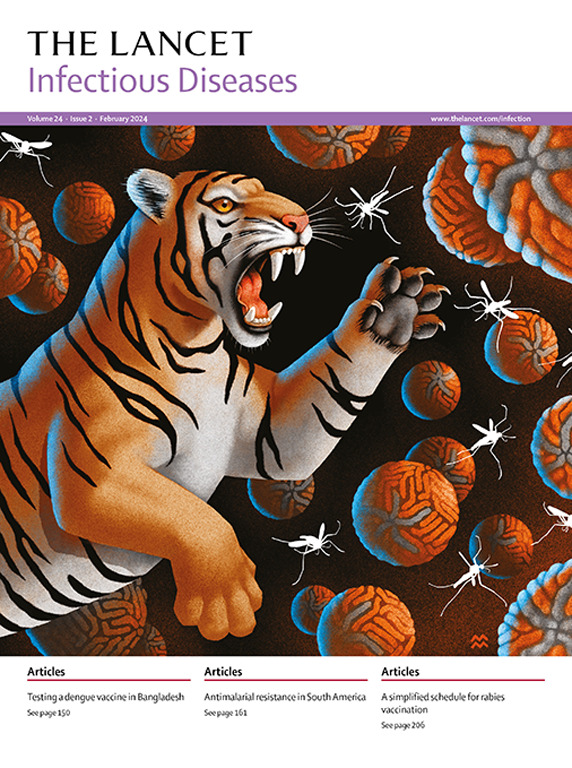克里米亚-刚果出血热的研究与产品开发:2024-30 年的优先事项
IF 36.4
1区 医学
Q1 INFECTIOUS DISEASES
引用次数: 0
摘要
克里米亚-刚果出血热(CCHF)是一种分布广泛、可能致命的蜱媒病毒性疾病,目前尚无获得许可的特定治疗方法或疫苗。2019 年,世卫组织发布了克里米亚-刚果出血热研发路线图预稿,其中优先发展和部署受克里米亚-刚果出血热影响的国家最需要的医疗对策。本《个人观点》介绍了最新的慢性阻塞性肺疾病研发优先事项,是 2023-24 年期间与由 20 名主要专家组成的工作组进行广泛磋商的成果。对战略目标、里程碑和时间表进行了修订和扩展,以反映自2019年以来的科学进展,包括具有治疗潜力的抗体的鉴定以及四种候选疫苗通过1期临床试验的进展。此次更新强调了采用 "一体健康 "方法管理 CCHF 的必要性,从跨部门综合监测到针对蜱及其脊椎动物宿主的新型干预措施,以减少 CCHF 病毒对人类的传播。到 2028 年实现快速诊断和特效治疗,到 2030 年实现限制 CCHF 病毒传播和控制疾病的方案,这是一个雄心勃勃的总体愿景,只有通过受影响国家、资助者、科学家、产品开发商、制造商、监管机构、国家当局和政策制定者采取协调一致的国际行动才能实现。本文章由计算机程序翻译,如有差异,请以英文原文为准。
Research and product development for Crimean–Congo haemorrhagic fever: priorities for 2024–30
Crimean–Congo haemorrhagic fever (CCHF) is a widely distributed and potentially fatal tick-borne viral disease with no licensed specific treatments or vaccines. In 2019, WHO published an advanced draft of a research and development roadmap for CCHF that prioritised the development and deployment of the medical countermeasures most needed by CCHF-affected countries. This Personal View presents updated CCHF research and development priorities and is the product of broad consultation with a working group of 20 leading experts in 2023–24. The strategic goals, milestones, and timelines have been revised and expanded to reflect scientific advances since 2019, including the identification of antibodies with therapeutic potential and the progression of four vaccine candidates through phase 1 clinical trials. This update emphasises the need for a One Health approach to manage CCHF, from integrated cross-sectoral surveillance to novel interventions that target ticks and their vertebrate hosts to reduce CCHF virus transmission to humans. The overarching vision for rapid diagnostics and specific therapeutics by 2028, followed by options to limit CCHF virus transmission and control disease by 2030, is deliberately ambitious and will only be achieved through coordinated international action from affected countries, funders, scientists, product developers, manufacturers, regulators, national authorities, and policy makers.
求助全文
通过发布文献求助,成功后即可免费获取论文全文。
去求助
来源期刊

Lancet Infectious Diseases
医学-传染病学
CiteScore
60.90
自引率
0.70%
发文量
1064
审稿时长
6-12 weeks
期刊介绍:
The Lancet Infectious Diseases was launched in August, 2001, and is a lively monthly journal of original research, review, opinion, and news covering international issues relevant to clinical infectious diseases specialists worldwide.The infectious diseases journal aims to be a world-leading publication, featuring original research that advocates change or sheds light on clinical practices related to infectious diseases. The journal prioritizes articles with the potential to impact clinical practice or influence perspectives. Content covers a wide range of topics, including anti-infective therapy and immunization, bacterial, viral, fungal, and parasitic infections, emerging infectious diseases, HIV/AIDS, malaria, tuberculosis, mycobacterial infections, infection control, infectious diseases epidemiology, neglected tropical diseases, and travel medicine. Informative reviews on any subject linked to infectious diseases and human health are also welcomed.
 求助内容:
求助内容: 应助结果提醒方式:
应助结果提醒方式:


